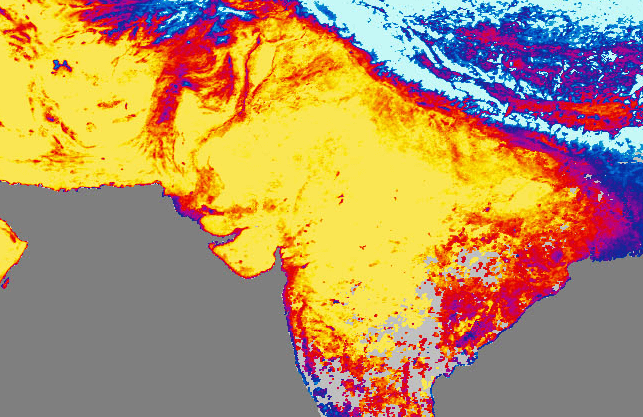 SOUTH ASIA (May 23, 2018) – Pakistan and India are being afflicted with intensely hot weather that is affecting residents throughout both countries.
SOUTH ASIA (May 23, 2018) – Pakistan and India are being afflicted with intensely hot weather that is affecting residents throughout both countries.
Unfortunately, the term “hot weather” does not translate into every American English any easier than if we were reading it in Hindi. The subcontinent has been experiencing temperatures exceeding 40 degrees Celsius. For those of us more familiar with the Fahrenheit scale, 40°C equals 104°F.
At least 65 people have already died in Karachi due to continuous exposure to extreme heat which has climbed as high as 45°C (113°F).
The Palam Observatory near Delhi, India, recorded the temperature at 46°C (114.8°) on Tuesday, May 22nd.
Skymet Weather expects no relief for at least several more days.
Did you know that, although heat waves are atmospheric conditions, they are not included in most lists of natural disasters, as are typhoons, floods, and earthquakes? Yet, just three years ago, more than 2,400 people in India died due to exposure during a similar heat wave. The irony is that is more than the number of deaths that year due to any other natural disaster.
That same year (2015) more than 1,200 people in Karachi, Pakistan, died from exposure to the heat.
The physical problems caused by intense heat waves in South Asia go beyond the pale of the average person’s imagination. Consider,
- The areas of highest risk of illness or death from South Asian heat waves are those that are less urbanized where people have fewer household amenities and less access to clean water and sanitation.
- People who labor outdoors – usually those who need to work to make ends meet – are the most exposed to the dangers of heat waves. They must make daily decisions about their personal health versus the welfare of their families.
- The primary danger of heat waves is dehydration. This place homeless and elderly in the most extreme danger according to the National Disaster Management Authority of India.
The expansive growth of cities such as Karachi has decimated the “green cover” of the city, with concrete and steel replacing the previously abundant vegetative shade and cover. One Karachi-based urban designed has predicted, “With the extremity of these issues and no initiative to address them, in 15 years this city won’t be livable.”
The problem is compounded for the Muslim population of South Asia which began their month-long observation of Ramadan on 14 May. Muslims refrain from eating or drinking anything – including water – between sunrise and sunset during their month-long fast, making them especially vulnerable to the elevated heat.
Times like these are reminders to government agencies and NGOs of the need for the provision of clean, potable water for those who lack it. Gospel for Asia drills Jesus Wells and provides BioSand water filters, whilst other agencies including WaterAid, Charity: Water, Water.org, Splash, WaSH and dozens of others work tirelessly to provide access to clean water that is so desperately needed for health and survival.
Pray and give so that we can continue to provide life-giving water where the need is great.
Sources:
- Financial Express, Heatwave in India 2018: Delhi NCR sizzles as mercury crosses 45 degree Celsius, IMD sees little respite ahead
- Hindustan Times, Heatwave to continue for four more days, temperature may soar to 45 degrees Celsius
- India Today, Heatwave grips India
- CNN, Heatwave kills at least 65 in Pakistan
- SkyMetWeather, Heatwave in Delhi: Mercury soars to 46 degrees, threat of heat stroke looms large
- FirstPost, India’s poorest areas are the most vulnerable to heat waves as planning targets cities
- The Guardian, Death toll climbs in Karachi heatwave
- IndiaSpend, India To Become 2-4◦ C Warmer, But Heat Deaths Are Preventable
Image Source:
- NASA, Visible Earth, free to use
For more information about this, click here.




